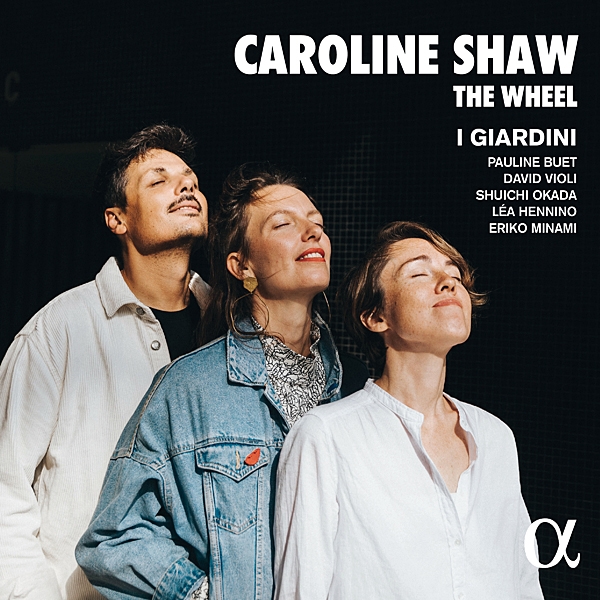| Columns Retired Columns & Blogs |
I discovered this through your (and Jim's) comments. Amazing stuff.

Prolific composer, vocalist, and violinist Caroline Shaw, who turned 40 just last year, possesses a unique gift—one that earned her the 2013 Pulitzer Prize in Music. Shaw has translated the old performer edict "Don't let them see you sweat" into her compositional craft and mastered the art of expressing complex thoughts economically through the simplest of means. Using minimal gestures, spare instrumentation, and unpredictable shifts in rhythm, pitch, and texture, she manages to create one masterful, all-engrossing composition after the other.
The latest recording of Shaw's music, The Wheel, from France's I Giardini artist collective, offers a superb introduction to Shaw's talents. It's also one of the finest recordings I've encountered; engineer/producer Olivier Rosset's recording is on par with Jim Anderson and Ulrike Schwarz's recent efforts for Patricia Barber and Jane Ira Bloom and Morten Lindberg's continuing triumphs on his 2L label. The Wheel's astoundingly wide dynamic range rivals that of Translations, John Atkinson and Doug Tourtelot's superb recording of the Portland State Chamber Choir. For air, tonal variety, depth, texture, and visceral/emotional impact, The Wheel is one of the finest chamber recordings I've encountered.
I Giardini commissioned the title composition, "The Wheel," for piano and cello, and premiered it in 2021. In her ultra-revealing liner notes, Shaw describes the 10:23 work as "a brief journey through a landscape made of musical memories." She equates her sounds to "the feeling of walking alone through the city at night, accompanied by one's inner voices and reflections."
Short as "The Wheel" may be (and three of the recording's six compositions are even shorter), I found it haunting. Often still and mysterious, with a soft, steady pulse that shifts in unpredictable ways, its impact is magical. The colors and timbres Rosset captures here and elsewhere are marvelous. At one point, I heard water dripping slowly from a spigot and imagined how such pedestrian sounds can, inexplicably, open universes. A little more than four minutes in, Pauline Buet's cello grows rhapsodic and the sounds from David Violi's piano intensify. Three minutes later, the heart seems to open. Then, without warning, thoughts and memories reassert themselves and we journey to another, simpler but more dramatic landscape. A surprising soft vocalization brings us back home. If you can embrace simplicity as a gateway to complexity, you can feel the impact Shaw's music can have on those who sit quietly in the dark and allow it to have its way.
"Boris Kerner," for cello + flower pots, blew me away. Who would have ever thought that two instruments could convey the essence of the book Introduction to Modern Traffic Flow Theory and Control: The Long Road to Three-Phase Traffic Theory—a book written by the man named in the title—in less than eight minutes? Not that I've read it—but I've heard the wonders Shaw creates from it. In her brief commentary, Shaw states that "Boris Kerner" is "another in a series of expositions on the curious phrase 'the detail of the pattern is movement.'" Curious. At one point, I wondered if Buet's cello was fighting back as Eriko Minami's flower pots seemed set on altering course. As the music continued, timbres and harmonics were so naked as to seem almost pornographic. I never thought flower pots could emit sounds as sensual and enrapturing as those transmitted by this recording.
Buet returns in "In Manus Tuas" for solo cello. Written in 2009 for cellist Hannah Collins, it was conceived for a secular compline service with a solo cello in the dark, candlelit nave of Christ Church in New Haven, Connecticut. Shaw says the piece was intended to convey a single moment of the experience of hearing a 16th century motet by Thomas Tallis in that Christ Church space. After I listened for a second time, I turned briefly to PS Audio's DSD recording of Zuill Bailey playing J.S. Bach's Six Suites for Unaccompanied Cello to see if it would confirm my first impression that the two recordings were equally convincing and impactful. The answer was yes.
The Wheel ends with its shortest composition, "Limestone and Felt." As Shaw contrasts the textures and ranges of cello and viola, her rhythms and melodies (to the extent that there are melodies) sound the most pop-ish of anything on the disc. It's common for string players to transition from plucking to bowing, but here the effect is radical, as though everything that is known or will be known has shifted fundamentally. Like every other composition on this 56-minute recording, it's a must-hear.—Jason Victor Serinus

I discovered this through your (and Jim's) comments. Amazing stuff.


Simple, yet complex. Delicate, yet powerful. Beautiful music! Thank you for the recommendation.
-Monty